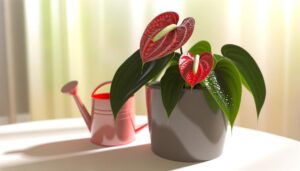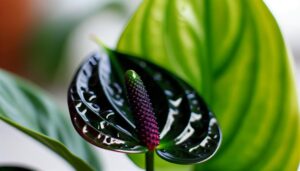What Makes Anthurium Black Cardinal Unique?
Anthurium Black Cardinal stands out for its glossy, deep burgundy leaves and unique heart-shaped foliage with efficient venation patterns. The plant's compact size, maturing at 12 to 18 inches, makes it ideal for indoor spaces.
It features a waxy cuticle for UV protection and antioxidant properties, with a purplish hue aiding in temperature regulation. To thrive, it needs bright, indirect light, high humidity levels, and well-draining soil.
Propagation is straightforward via stem cuttings or division. If you're curious about its care requirements and propagation methods, continue exploring the detailed guidelines.
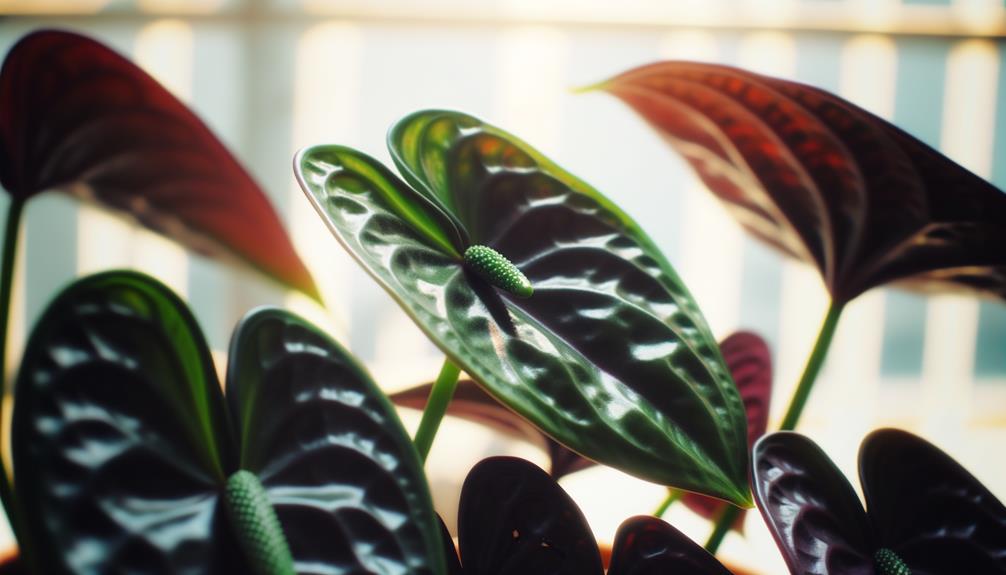
Key Takeaways
- Striking dark foliage with glossy, deep burgundy leaves.
- Unique heart-shaped leaves with efficient venation patterns.
- Compact growth habit, maturing at 12 to 18 inches.
- Waxy cuticle provides UV protection and antioxidant properties.
- Distinct purplish hue aids in temperature regulation.
Striking Dark Foliage
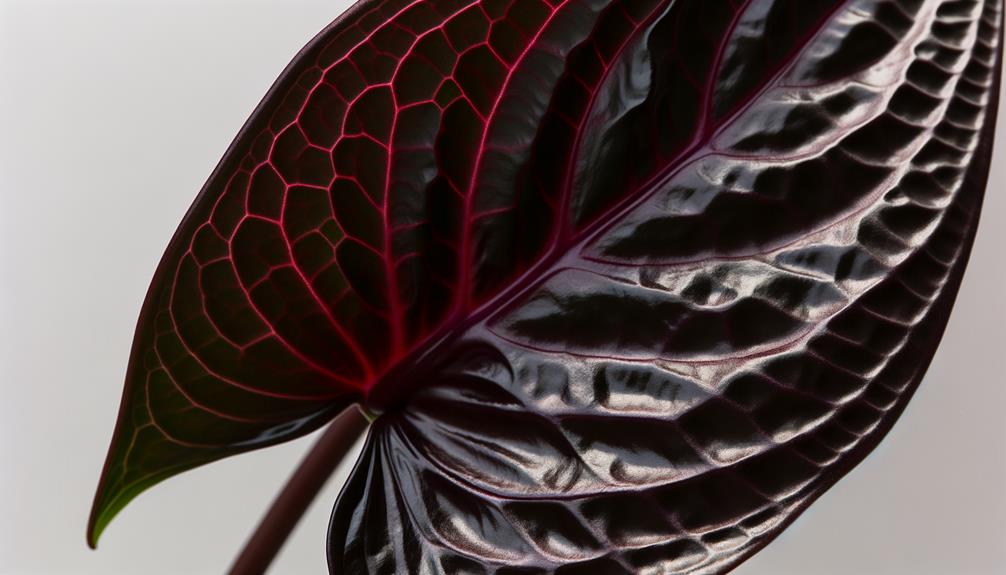
With its glossy, deep burgundy leaves, Anthurium Black Cardinal stands out as a striking example of dark foliage in the plant world.
You'll notice the leaves' rich pigmentation results from high anthocyanin concentrations, a type of flavonoid known for its antioxidant properties.
This unique coloration not only adds aesthetic appeal but also provides a layer of protection against UV radiation.
The waxy cuticle on the leaf surface enhances light reflection, giving the foliage its characteristic sheen.
When you examine the leaf's underside, you'll observe a purplish hue, a trait that aids in temperature regulation and moisture retention.
This sophisticated interplay of pigments and leaf surface adaptations makes the Anthurium Black Cardinal a botanically fascinating specimen.
Unique Leaf Shape
You'll notice the Anthurium Black Cardinal's leaves are distinctly heart-shaped, a characteristic that enhances its ornamental allure.
Their glossy texture maximizes light reflection, creating a striking visual effect.
This, combined with the dark coloration, forms a captivating contrast that draws immediate attention.
Distinctive Heart Shape
The Anthurium Black Cardinal boasts a distinctive heart-shaped leaf, a feature that results from its unique genetic morphology and cellular structure. When you observe the leaf, you'll notice its broad, symmetrical base tapering into a pointed apex, resembling an anatomical heart. This shape isn't just aesthetically pleasing; it maximizes surface area for photosynthesis.
Subtle venation patterns, visible upon close inspection, reveal the plant's efficient vascular system, ensuring ideal nutrient and water transport. Genetic studies indicate that specific alleles contribute to this shape, distinguishing it from other Anthurium varieties.
Moreover, the cellular architecture, particularly the arrangement of parenchyma cells, enhances the leaf's structural integrity and adaptive capabilities. This heart shape exemplifies evolutionary adaptation, making your Anthurium Black Cardinal truly unique.
Glossy Leaf Texture
Observing the Anthurium Black Cardinal, you can't help but notice its glossy leaf texture, which results from a unique combination of epicuticular waxes and specialized epidermal cell structures. These waxes form a hydrophobic layer, reducing water loss, while the epidermal cells enhance light reflection, creating that remarkable gloss.
| Feature | Function |
|---|---|
| Epicuticular Waxes | Hydrophobic layer, reduces water loss |
| Epidermal Cells | Enhance light reflection |
| Leaf Gloss | Aesthetic appeal, deters herbivory |
| Surface Smoothness | Minimizes dust accumulation |
| Structural Integrity | Supports leaf shape and rigidity |
This glossy texture not only offers aesthetic appeal but also boosts the plant's efficiency in photosynthesis by maximizing light absorption. You'll find yourself mesmerized by the way light dances off its surface, revealing the intricate interplay of plant anatomy and environmental adaptation.
Dark Coloration Contrast
Beyond the mesmerizing gloss, the Anthurium Black Cardinal's dark coloration provides a striking contrast, highlighting its uniquely shaped leaves and amplifying its visual impact in any botanical setting.
The deep, almost velvety black hue juxtaposes sharply against the vibrant green veins coursing through each leaf, creating a visually arresting spectacle. This chromatic interplay accentuates the leaf's heart-shaped structure with pronounced lobes and pointed tips, a distinctive morphology that's both elegant and robust.
Research indicates these contrasting colors may enhance photosynthetic efficiency by optimizing light absorption.
You'll find the Black Cardinal's dark pigmentation not only adds an exotic allure but also serves functional benefits, making it a remarkable specimen in any plant collection.
Growth and Size
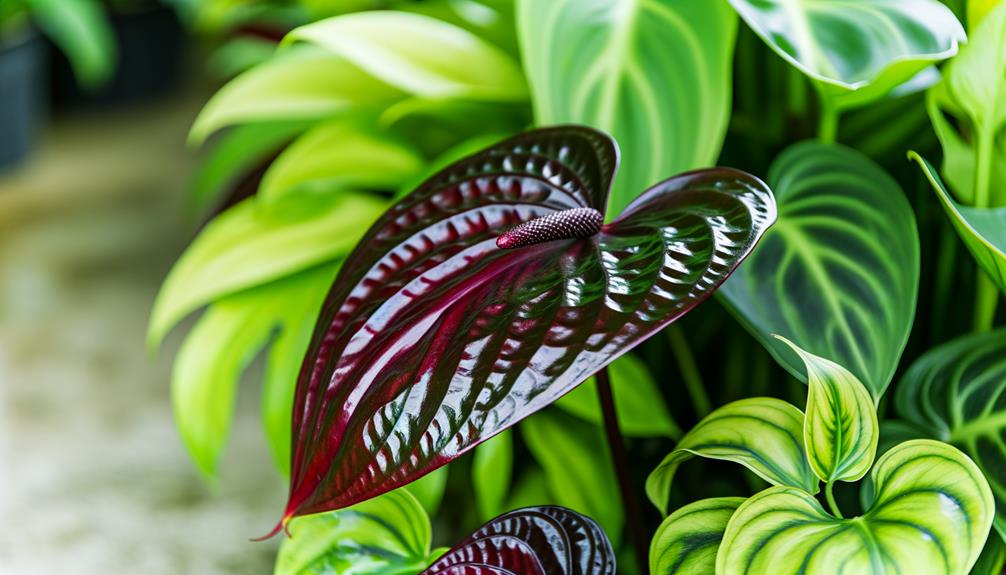
Anthurium Black Cardinal typically reaches a mature height of 12 to 18 inches, making it a manageable size for indoor cultivation. You'll appreciate its compact growth habit, which suits various indoor spaces. The plant's broad, leathery leaves can span up to 8 inches in width, providing a striking visual impact.
Key growth characteristics include:
- Stem Structure: Short and robust, supporting the large, dark-hued leaves effectively.
- Leaf Development: New leaves emerge with a bronze tint before darkening to a deep blackish-green.
- Root System: Adventitious roots aid in nutrient absorption and stability.
With its moderate growth rate, the Anthurium Black Cardinal won't overwhelm your space, yet it offers enough presence to be a captivating focal point.
Care Requirements
You'll need to provide Anthurium Black Cardinal with bright, indirect light and regular watering to maintain best soil moisture.
Use a well-draining potting mix rich in organic matter to guarantee proper root aeration.
Maintain high humidity levels around 60-80% to mimic its natural tropical habitat.
Light and Watering Needs
To accomplish ideal growth, position your Anthurium Black Cardinal in bright, indirect light and maintain consistent moisture levels without overdoing it. This species thrives in diffused sunlight, mimicking its native understory habitat. Avoid direct sunlight, which can scorch the leaves, and guarantee your plant receives 60-70% humidity.
Regularly monitor the plant's environment to make adjustments, ensuring your Anthurium Black Cardinal remains healthy and vibrant.
- Light Intensity: Use a light meter to verify levels are between 1000-2000 foot-candles.
- Watering Frequency: Water when the top inch of soil feels dry. Overwatering leads to root rot.
- Water Quality: Use distilled or rainwater to prevent chlorine and fluoride buildup.
Soil and Humidity
Maintaining ideal soil and humidity levels is crucial to ensuring your Anthurium Black Cardinal flourishes. Aim for a well-draining, peat-based potting mix enriched with perlite or orchid bark, ensuring aeration and moisture retention. This mimics the plant's natural epiphytic environment.
Keep humidity levels between 60-80%, as high humidity encourages lush growth and prevents leaf browning. Use a humidifier or pebble tray, especially during dry seasons. Mist the leaves occasionally, but avoid waterlogging the soil.
Monitor for signs of distress like wilting or yellowing, indicating improper moisture levels. By balancing soil composition and ambient humidity, you'll create an excellent microenvironment for your Anthurium Black Cardinal to thrive.
Ideal Growing Conditions
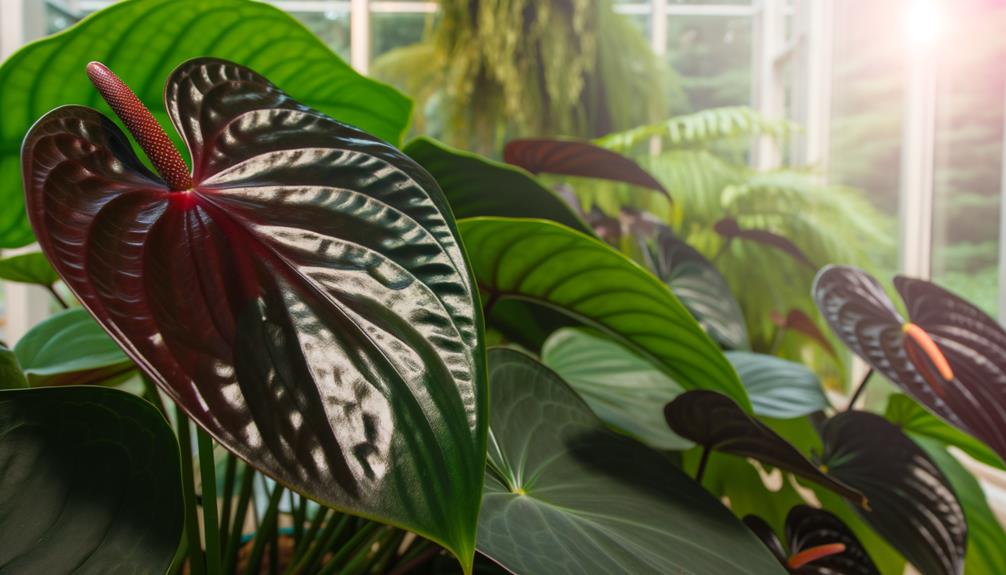
Anthurium Black Cardinal thrives best in bright, indirect light and requires a well-draining, organic-rich soil to promote growth. You should guarantee the environment mimics its native tropical habitat. This involves maintaining consistent humidity levels around 60-80% and temperatures between 65-80°F.
To optimize growth:
- Light: Place your plant where it gets filtered sunlight to prevent leaf scorching.
- Watering: Water moderately, allowing the top inch of soil to dry out between waterings to avoid root rot.
- Humidity: Use a humidifier or mist the leaves regularly to maintain high humidity.
These conditions are essential for fostering vibrant foliage and overall plant health. Adhering to these guidelines will help you cultivate a thriving Anthurium Black Cardinal in your home.
Propagation Methods
Once you've established the ideal growing conditions, you can propagate the Anthurium Black Cardinal through stem cuttings or division to expand your collection. For stem cuttings, select a healthy stem with at least one node and a few leaves. Using a sterilized knife, cut below the node. Dip the cut end in rooting hormone and plant it in a well-draining potting mix. Keep the soil moist and maintain high humidity.
Alternatively, division involves gently removing the plant from its pot and separating the root ball into smaller sections, ensuring each section has roots and foliage. Replant each section in its own pot with fresh soil.
Both methods require patience and careful attention to detail for successful propagation.
Common Pests and Issues
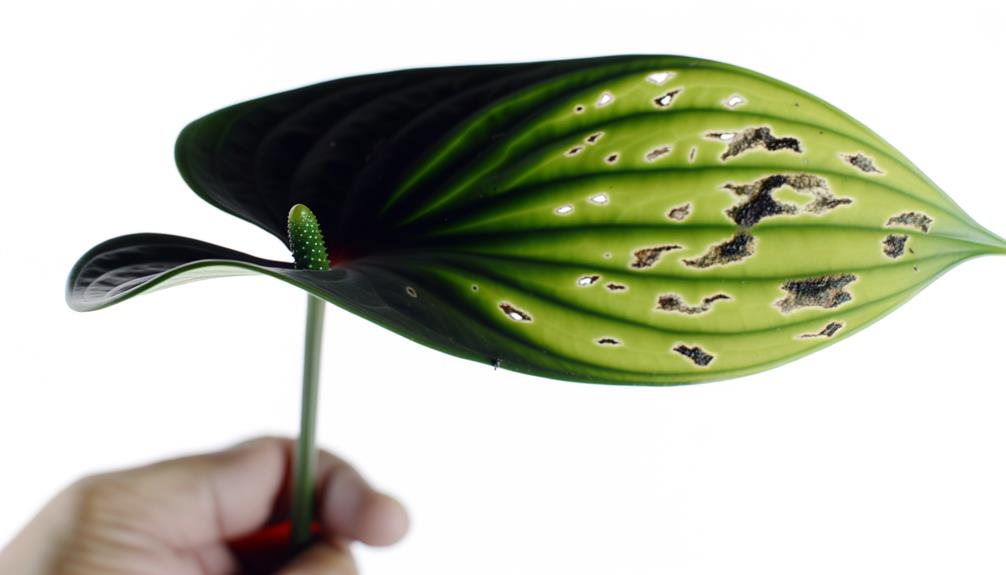
You'll likely encounter a few common pests and issues with the Anthurium Black Cardinal, including spider mites, aphids, and root rot, which can severely impact the plant's health.
Spider mites are tiny arachnids that cause stippling on leaves and webbing. Aphids, small sap-sucking insects, lead to distorted growth and mold development.
Root rot, caused by overwatering or poor drainage, results in brown, mushy roots and wilting foliage.
To address these issues:
- Inspect regularly: Check leaves and roots for early signs of pests or disease.
- Maintain proper watering: Guarantee the soil is well-draining to prevent root rot.
- Use insecticidal soap: Apply as necessary to control spider mites and aphids.
Decorative Uses
Maintaining your Anthurium Black Cardinal free from pests and diseases allows you to maximize its potential as a striking decorative element in both indoor and outdoor settings. Its deep, dark foliage provides a dramatic contrast to lighter plants, making it an excellent focal point.
When placed indoors, it thrives in bright, indirect light, adding a touch of sophistication to living rooms or office spaces. Outdoors, it can be a stunning addition to shaded garden areas. Research shows that its air-purifying qualities enhance indoor air quality, making your space healthier.
Position it in decorative pots or hanging planters to exploit its cascading growth habit. Regular upkeep, including pruning and proper watering, guarantees it remains an aesthetic centerpiece year-round.
Conclusion
To sum up, the Anthurium Black Cardinal captivates with its striking dark foliage, charms with its unique leaf shape, and impresses with its manageable growth and size.
You'll find its care requirements straightforward, its ideal growing conditions attainable, and its propagation methods feasible.
Despite potential pest issues, its decorative uses are vast and versatile.
Embrace the elegance, relish the rarity, and cultivate the charm of the Anthurium Black Cardinal in your botanical collection.


